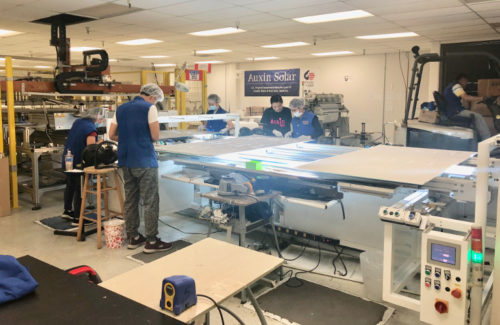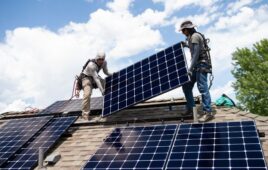American-owned solar panel assembly facility Auxin Solar today filed a petition with the U.S. International Trade Commission (ITC) to extend safeguard relief for crystalline silicon photovoltaic (CSPV) cells and modules. Safeguard tariffs were initiated in 2018 after U.S. manufacturers Suniva and SolarWorld filed a Section 201 petition with the ITC, claiming that imported solar cells and panels were coming into the country so cheap that they were killing the U.S. solar manufacturing market. Auxin Solar was later added as a supporter of the tariffs. Auxin makes its own solar panels in its facility in San Jose, California, but largely acts as an OEM. All solar cells it uses are imported.
“Extending this safeguard is essential for America to reclaim its lead in solar energy manufacturing and development, and it represents a critical step to achieve the broader goal of American renewable energy independence,” said Mamun Rashid, co-founder and chief executive officer at Auxin Solar. “This is about national security and realizing the promise of green energy independence. We believe the Commission should recommend extending the safeguard remedy for another four years to strengthen the domestic solar industry. Auxin Solar is committed to re-shoring the solar supply chain and filed this petition in the hope that policymakers are committed to the promise of green energy independence and the good-paying manufacturing jobs that will result.”
The safeguard tariffs were set on a four-year drop-down schedule beginning in 2018, with full expiration expected in February 2022. Imported bifacial solar panels were excluded from the import tariffs for a short time but are today taxed the same as traditional solar panels. All types of imported crystalline silicon solar panels (except for a few minor exemptions) have faced an 18% tax since February 2021.
See Solar Power World’s archived tariff coverage here.
Auxin Solar is joined by recently-emerged-from-bankruptcy-but-still-dormant Suniva on today’s extension petition. The ITC is now prompted to determine whether the safeguard remedy continues to be necessary to prevent or remedy serious injury, and whether there is evidence that the industry is making a positive adjustment to import competition. The ITC will report its determination to President Joe Biden by December 8, 2021, and at that time the President may choose to extend the safeguard remedy for an additional four years.
Auxin says that the extension of the safeguard remedy is necessary because neither Auxin Solar nor Suniva have been able to complete their plans to positively adjust to import competition.
“Auxin Solar and Suniva’s investment plans were negatively impacted by stockpiling prior to the establishment of the safeguard, economic headwinds caused by COVID-19, China’s predatory pricing, and a loophole in the remedy that allowed excluded modules to be imported in high volumes and at cut-rate prices. These combined challenges meant that the safeguard did not have the desired effect to allow companies like Auxin Solar and Suniva to recover from the serious injury caused by imports,” said Auxin in a press release.
Auxin joined Suniva and other domestic module manufacturers at a tariff midterm review in 2019. Mission Solar (Texas), LG Electronics (Alabama) and SunPower (now no longer manufacturing in the United States) all stated that they supported the tariffs.
No other U.S. solar companies are listed as supportive of today’s petition announcement, although Auxin and Suniva stated in the petition that Q CELLS (Georgia), LG and Mission Solar “may be making their position known to the Commission after this filing.”
Solar industry advocacy group SEIA released a statement:
“There are no two ways about it. It is time to end the job-killing Section 201 solar tariffs. They are a multibillion dollar drag on industry growth. And leading domestic panel manufacturers are thriving, both here in America and globally. If we hope to reach our ambitious climate goals, we must accelerate solar deployment, not hinder it with unnecessarily punitive trade measures,” said John Smirnow, VP of market strategy and general counsel for SEIA. “The way to create more U.S. manufacturing is long-term federal investments, not shortsighted tariffs. Indeed, SEIA is advocating for a suite of federal policy options designed to provide demand certainty, leverage private sector capital investments and provide ongoing production support as gaps are filled in the domestic solar supply chain. We’ve also set a target of 50 GW of solar manufacturing capacity by 2030. That would go a long way toward creating a robust solar manufacturing supply chain, but we won’t get there with a simplistic and ineffective trade policy.”
Updated Aug. 3 with SEIA comments






Tell Us What You Think!